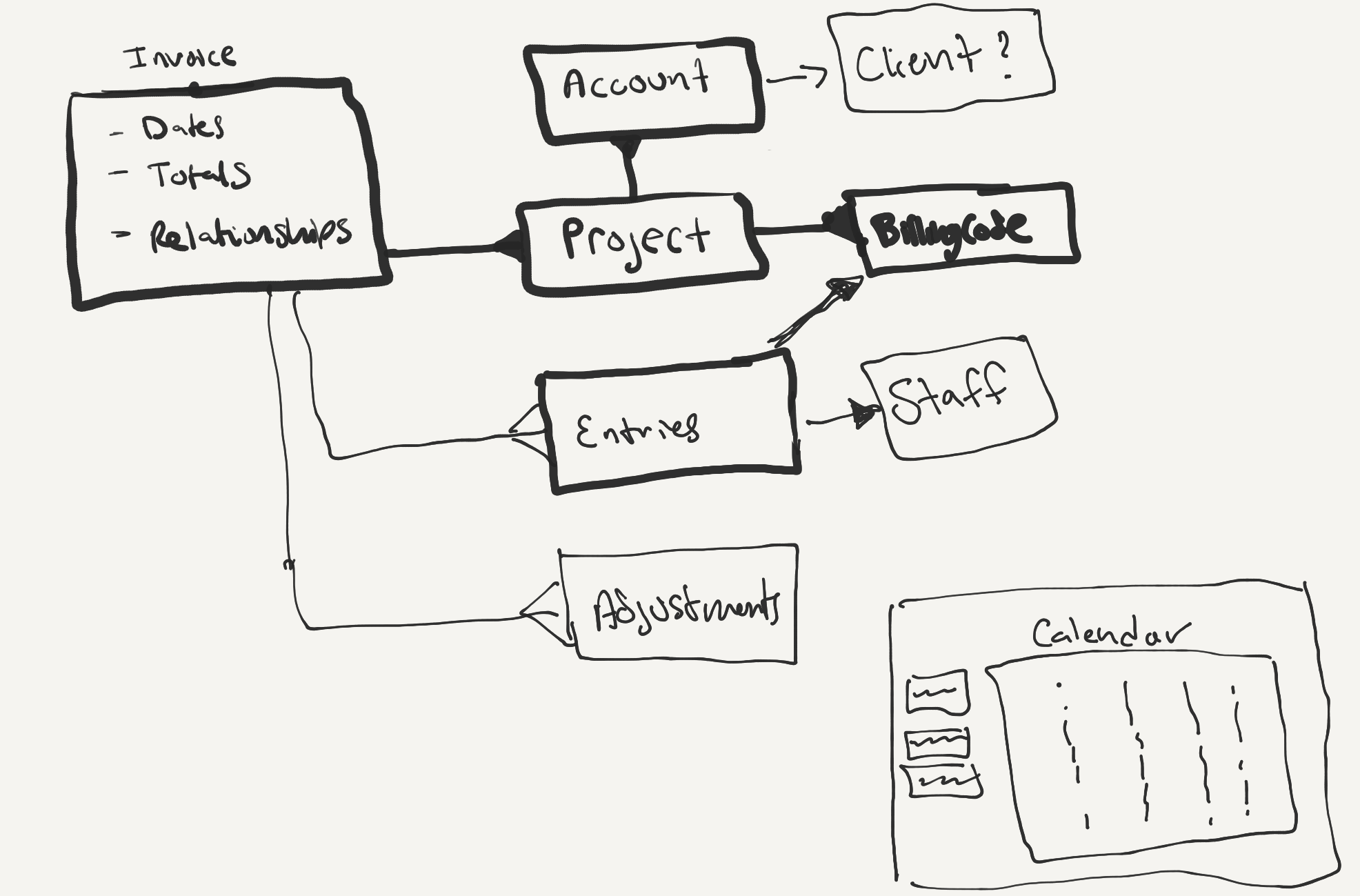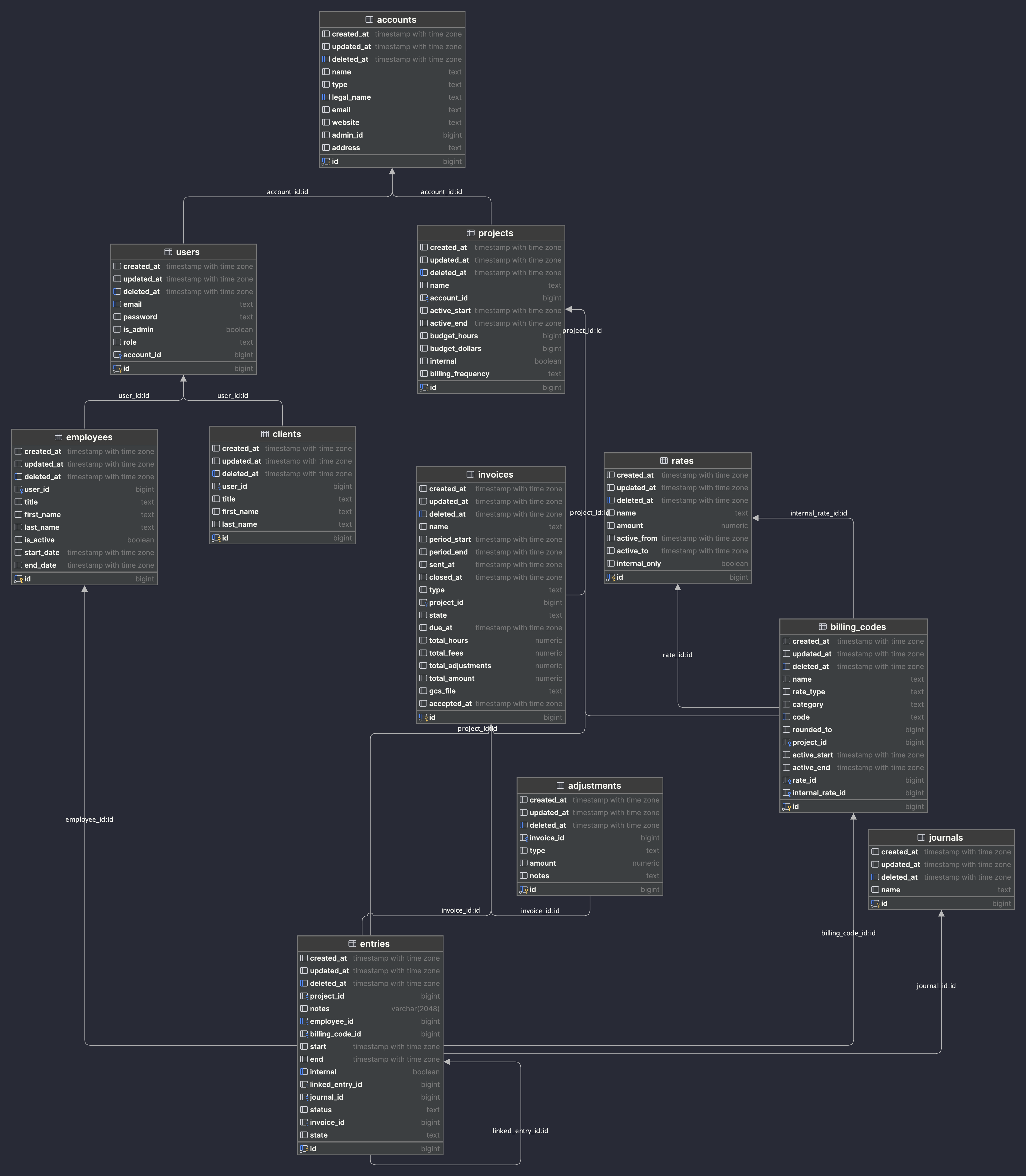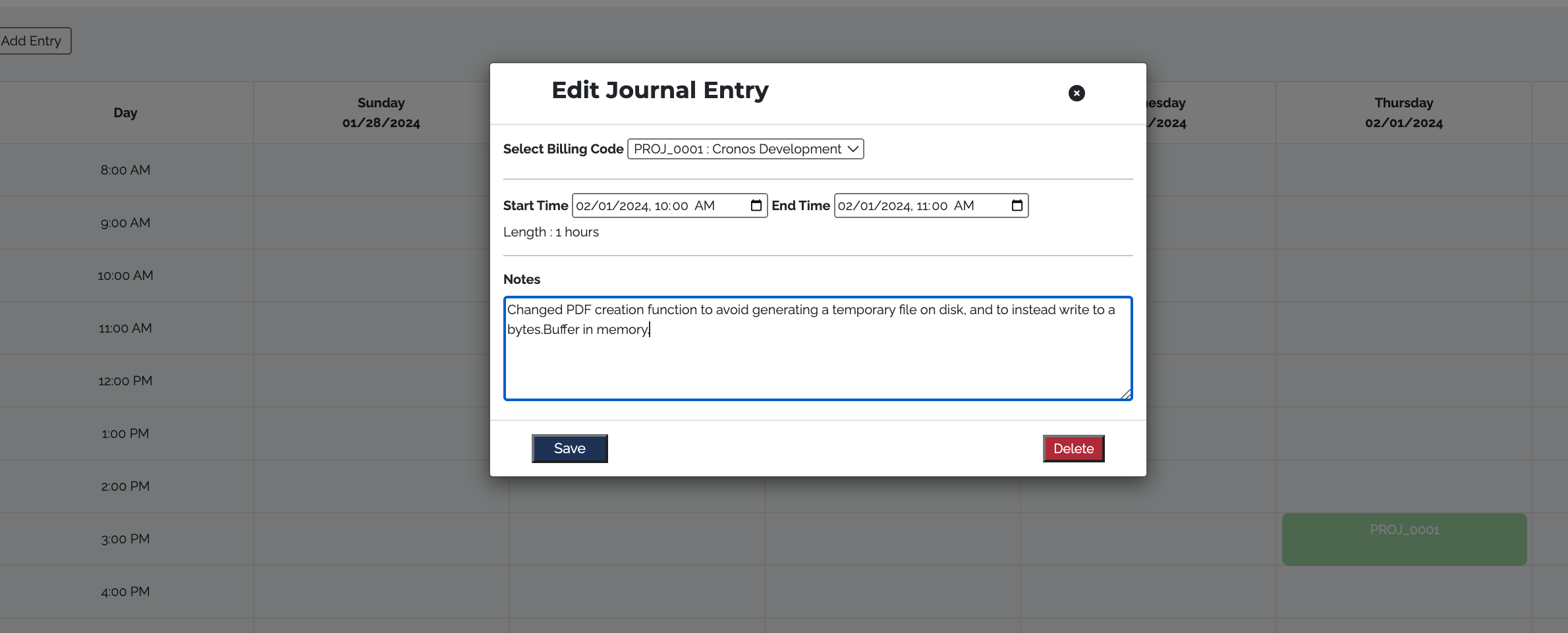Building Project Cronos
A peek into the development of our internal time tracking and project management tool
Nate Robinson | February 1, 2024This is a deep technical-dive into the development of Project Cronos as an accompaniment to our brief intro to the tool. The time that goes into developing these tools is often overlooked. We hope this post serves as both a roadmap for others seeking to build custom tools and as an exhibit of the dedication we have to quality work.
Motivation
Project Cronos began as a side project a few months ago at Snowpack. My entire career I've spent a generous amount of my free time thinking about and working on side projects. Some of those have become open source tools or companies, and some just fun challenges for myself, but all have been excellent learning experiences. I've been especially motivated by the development of bespoke tooling, I really enjoy automating and optimizing the boring parts of my job and there's been no better place than Snowpack for me to do that in a way that benefits both myself, and the clients that I work with.
The goal of Project Cronos was to reduce the manual overhead spent managing timesheets and invoices for the Snowpack team. We recognize that we do not need a full-fledged time tracking system, but we do need something more advanced and auditable than a spreadsheet for keeping track of work spent across projects. With just 3 members at the time, combining our individual spreadsheets was already becoming an annoying affair, I couldn't imagine the pain as we began to expand. After a particularly egregious month of invoicing, I began sketching out a solution. Since then, the project has slowly expanded to become an entire internal project management system. I do want to get one point out of the way first, yes there are dozens if not hundreds of similar tools out there, some of them probably fit our needs, and some of those are probably even free or low cost. But as builders and developers, we find joy in building our own tools, and I think that's what makes us so innovative, nobody created anything new by subscribing to someone else's software. The experience that our team and clients have with Project Cronos should represent who we are as company, professionals who deliver highly bespoke, thoroughly thought-out, and well-crafted solutions without compromise.
 Landing page upon logging into the Cronos application.
Landing page upon logging into the Cronos application.
Architecture
My corporate career began at Digitas, a large digital marketing agency, in which I started working across a number of small clients. Part of every week was spent filling out timesheets, an arduous process rife with error and frustration. Even then, I often thought about ways to improve the process. That experience gave me a good understanding of both the necessary requirements and the pitfalls these types of technologies have. When I began to think about the architecture for Cronos, most of the components were obvious, so much so that I was able to sketch out the entire system in a few minutes.
 My ugly initial sketch of what would become the Cronos app.
My ugly initial sketch of what would become the Cronos app.
First began the architecture of the backend models. Obviously we needed a User, and a User would record work, or an Entry, to a Project. Next came the obvious, a Project must have an Account, and an Account must have Clients, who ... are also Users. Well that necessitates another model, an Employee (or staff) is a User, but only a staff member can submit an Entry, and a Client is also a User, but they can only view their own Projects. As you can see this becomes an iterative process. Ultimately we ended with the following core models: User, Entry, Project, Account, BillingCode, Rate, Client, and Employee. Why so many layers of abstraction? Well from what I learned using past systems, it's powerful to have re-usable components. For example, our Rates should be set by an administrator and available to only certain BillingCodes, we don't want any funny business, nor do want to have to create a new rate for each billing code when we can reuse the same one. Secondly, what if we have different types of staff each working on a project? We need to have each entry tied to a BillingCode, not a Project. This limits the amount of time required to add an entry, you simply select a BillingCode, which already has an associated Rate, and Project, and you're done. Not to mention BillingCodes have memorable names, I still remember some of the ones from my Digitas days, this reduces likelihood of user error.
 The moderately convoluted entity relationship diagram that defines Cronos.
The moderately convoluted entity relationship diagram that defines Cronos.
After the core function was sketched out, we turned to Invoicing. This resulted in a few additional models, an Invoice, an Adjustment, and a Journal. An Invoice contains a collection of Entries, potentially spanning multiple Staff or BillingCodes that are aggregated and invoiced to a client. This is a very powerful tool, as it allows us to invoice for a variety of services on a project in a single format without manually generating complex documents. If we needed to amend an invoice, we could add an object called an Adjustment. This allows us to keep a record of things like discounts, rebates, or additional fees. Finally, a Journal is the aggregate collection of entries, this operates behind the scenes and allows our team to do things like generate reports, handle accounting, and track the performance of our team.
Platform
So we've discussed architecture but what is this all built in? Cronos like much of my recent non-DS work is built in Golang. Golang offers many nice features for building web applications, the language is simple and fast, highly standardized, and encourages maintainable code with its strict typing and error handling. Our entire website is already built in Golang, so it was a natural choice to build Cronos in the same language and import the library into our website. As a side note, as data professionals I find it important for us to be able to work both across a stack and across languages, expanding my experience beyond Python and SQL has been a great learning experience and has made me a better developer no matter what language I'm working in.
There are a number of options for syncing the database components of a web application with the backend codebase, but for speed of development and ease of use, I chose to use GORM. GORM is a popular ORM for Golang, and while not fully featured is about as good as ORMs get in Go. Go discourages the use of ORMs and frameworks rendering the pool of options small. GORM nowhere near as powerful or flexible as Python's Django, but allows you to abstract most of the database operations and focus on the application logic so long as you avoid some of the more esoteric traps that it introduces. With the ORM in place, and a postgres database running on our server, we were able to quickly build out the models and begin testing the application. Much of the application is a simple CRUD API, we use to create, edit, and delete our objects. If I had to plug a single technology in this dev phase it would be GitHub Copilot. I wrote a relatively generic CRUD API for the first object myself, and then let Copilot abstract that template to the rest of the objects for me, building out the bulk of our API in seconds. It wasn't quite perfect, but saved me a few hours of boilerplate coding.
The Application
The real fun of the building this application was the business logic. After the basic CRUD API was built, I began to consider some of the more complex operations that we would need to perform. For example, when a user submits an Entry, that entry needs to be verified as valid for the project, added to the correct Journal, and then applied to the correct draft invoice. Another fun features is the ability to do a kind of "dual entry" accounting. When a staff member submits a billable entry, the system automatically created a linked entry to track their pay. Each billing code has instructions for how to generate this linked entry. This is necessary because staff may bill the same externally to clients against a single billing code, but each of those staff members may earn a slightly different hourly income for their work, this allows us to handle all of those contingencies and easily generate paystubs for hourly staff. If staff are salaried we can use these entries to calculate their utilization and profitability or lack thereof.
 Time entry form for recording time spent on a project.
Time entry form for recording time spent on a project.
Just as important as routing entries correctly was the ability for administrators to keep track of billable work, invoices, and budgets. Each project has a budget, whether that be in hours, dollars, or both. The administrator is able to see each of the entries as applied to an invoice in a draft state throughout the month to track if they are entered correctly, and if they are within budget. Once a billing period has closed the administrator can make any final edits before approving the invoice. Once approved the invoice is locked and cannot be edited, and the system will automatically generate a PDF of the invoice and with one click you can send it to the client. This is a huge time saver for our team, and having a permanent record of each invoice, the entries included with it, and the work that was done is a huge benefit for our team.
 Draft invoice for work recorded on the Cronos Project.
Draft invoice for work recorded on the Cronos Project.
One last fun little thing I enjoyed was building the simple underpinning logic for invoice/fees calculation. Different contracts might round billables to the nearest 15 minutes, or 30 minutes, or even 1 hour. We need to ensure that entries follow these rules, and that the system can handle the rounding correctly. Small code snippets like this are fun to write, and they are the kind of thing that makes a bespoke system like this so powerful.
// GetFee finds the fee for an entry in USD after accounting for round-off specific to the billing code
func (a *App) GetFee(e *Entry) float64 {
// Retrieve the BillingCode and its associated Rate
var billingCode BillingCode
a.DB.Preload("Rate").Where("id = ?", e.BillingCodeID).First(&billingCode)
// Find the Entry duration in minutes
durationMinutes := e.Duration().Minutes()
// Calculate the rounding factor as the percentage of an hour
roundingFactor := float64(billingCode.RoundedTo) / SIXTY_MINUTES
// Convert our duration in minutes to hours plus a decimal
hours := float64(durationMinutes) / SIXTY_MINUTES
// Round the hours to the nearest rounding factor, rounding down
roundedHours := float64(int(hours/roundingFactor)) * roundingFactor
// Use the rounded hours to calculate the fee
fee := roundedHours * billingCode.Rate.Amount
return fee
}
Security
But what about security! Well, given the nature of the data we are storing I ended up spending the largest chunk of time on security. I'm not a security expert, but I've been around the block a few times and I know the core concepts. Obviously we need to salt and hash passwords and other sensitive data, that is table stakes. Service accounts with tightly scoped permissions are provisioned to the application and used to handle operations with various external parties. We also need to limit the data that is available to users, the pages they can see, and the operations they can perform. Javascript Web Tokens (JWTs) are used for authentication, and we use a custom middleware to authenticate all requests. These tokens expire and are cycled prompting the user to re-authenticate routinely. Finally, we need to manage the use of secrets during deployment which is handled by CI/CD. The application code is in a private repo and secrets are secured via GitHub Secrets. When an update branch is merged to the main branch, the application is automatically rebuilt, the secrets are injected, and the application is redeployed limiting the ability for contributors to access secrets, or accidentally deploy them to GitHub.
 The sweet sweet success of all green on the CI/CD checks and deploy.
The sweet sweet success of all green on the CI/CD checks and deploy.
Building the Frontend
With the application working smoothly I began to think through how to actually record time. I wanted to make it as easy as possible to add entries, and I wanted to make it a seamless part of our daily workflow that avoided error. The logical solution was to make timesheet entries look like a calendar. We each spend a lot of time in our calendars, and the visual representation of time is a very natural way to think about it. It limits problems like double-entry over the same period, and offers visual feedback as to the productivity of your week. In a perfect world the calendar should be entirely full. My backend skills are certainly stronger than my frontend skills, so while the calendar is responsive and clean, you cannot create or resize an entry by dragging on the calendar (yet), you'll simply have to use the Add Entry button.
The calendar and the rest of our UI is built in Vue. My experience in front-end frameworks is limited to work I did nearly a decade ago in Angular2 and a few small projects in React. I chose Vue because of how similar it is to Angular, and because it's a bit more lightweight than React. I also wanted to learn something new, and I've been very happy with the choice. With Vue I am able to bind objects to the DOM, and use a number of built-in components to complete the functionality of the UI. I was also able to create some relatively bound functions that are used to handle event triggers for actions taken in the UI, and even a few sneaky DOM updates for responsiveness in the Calendar.
 The administrative UI for creating and editing core objects.
The administrative UI for creating and editing core objects.
Admittedly where I fall short is webpage design. While the functionality of the pages is there, I find the design a bit sterile. Despite having taught a web development course for the past 4 years, I've never been able to create a truly beautiful webpage, so we'll have to settle for a functional one! At the very least it's responsive, and thanks to some support from Tanya Z with a bunch of CSS suggestions, we have a cohesive theme across the entire application.
Challenges
So what were the key challenges in building out this application? I found the largest challenges were based in platform and security. The ever-changing structure of the GCP/AWS platforms and the security requirements of the applications renders some of our experience obsolete every year. I've deployed probably 15+ applications to cloud platforms in my career and every time I do it I have to relearn the process. While it feels like the technologies are getting more complicated, it feels like the process is getting easier, and this iteration feels like both the most secure and the most stable. I'm also very happy with the CI/CD pipeline and ease of contribution that introduces. The ability to test branches on commit, and automatically deploy to a staging environment is an absolute must for any modern application.
Next Steps
We have a ton of next steps already planned for Project Cronos. The first is to build out a customer portal, allowing our Clients to view their projects, download their invoices, and hopefully retrieve some useful reports. The groundwork exists for handling payroll with the dual entry system, but we need to build out the UI and some backend logic to handle the process. Finally also need to build out a more robust reporting system, we have a few standard reports in mind, but we also want to allow our team to build custom reports. This will be a fun challenge, and I'm looking forward to it.
Conclusion
I hope this has been an interesting read, and I hope it serves as a roadmap for others seeking to build their own custom software. We are really proud of the work we've put into this despite it being just a side project, but I'm glad it can exist as a sort of portfolio piece for our team, and a functional tool to alleviate some of our administrative overhead.
Snowpack specializes in helping organizations solve analytical problems. We work with clients to build and deploy a modern data for them that will scale as they grow. For more information, follow our blog, or shoot us an email at [email protected]